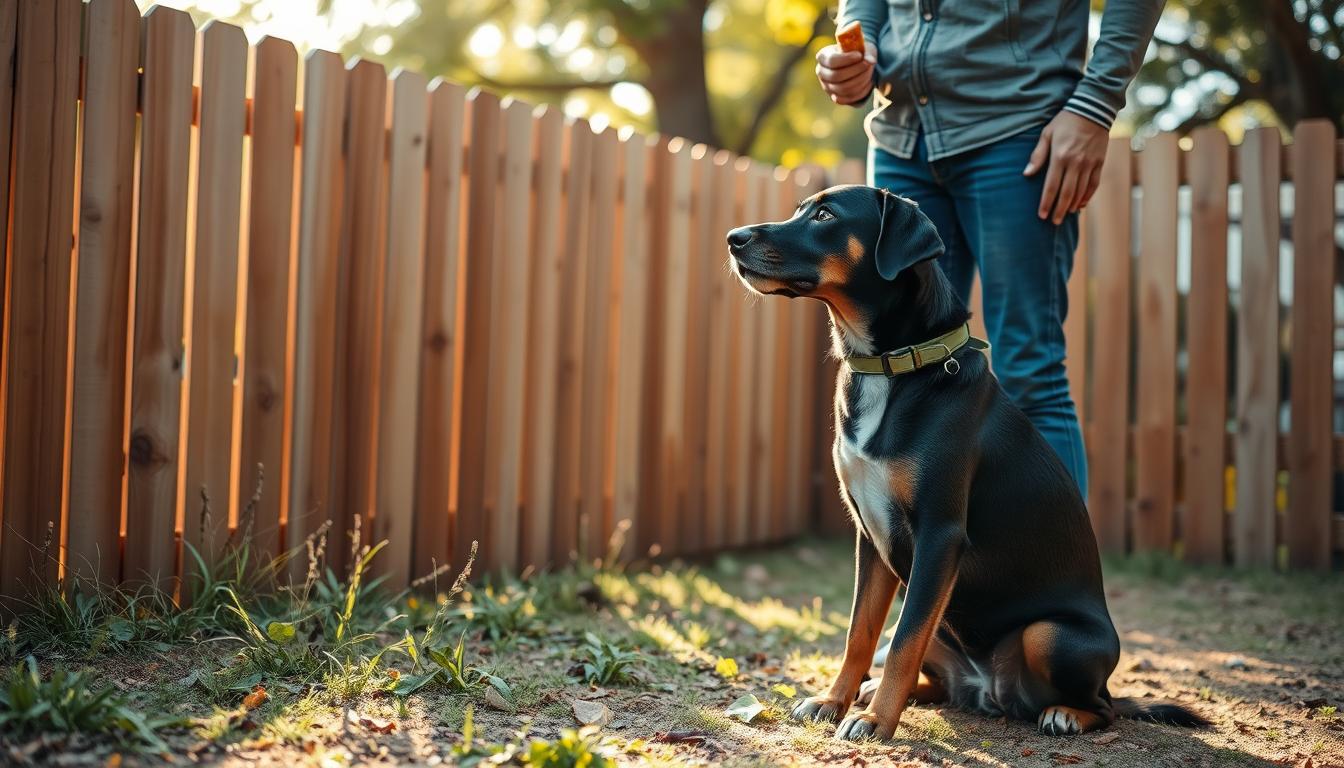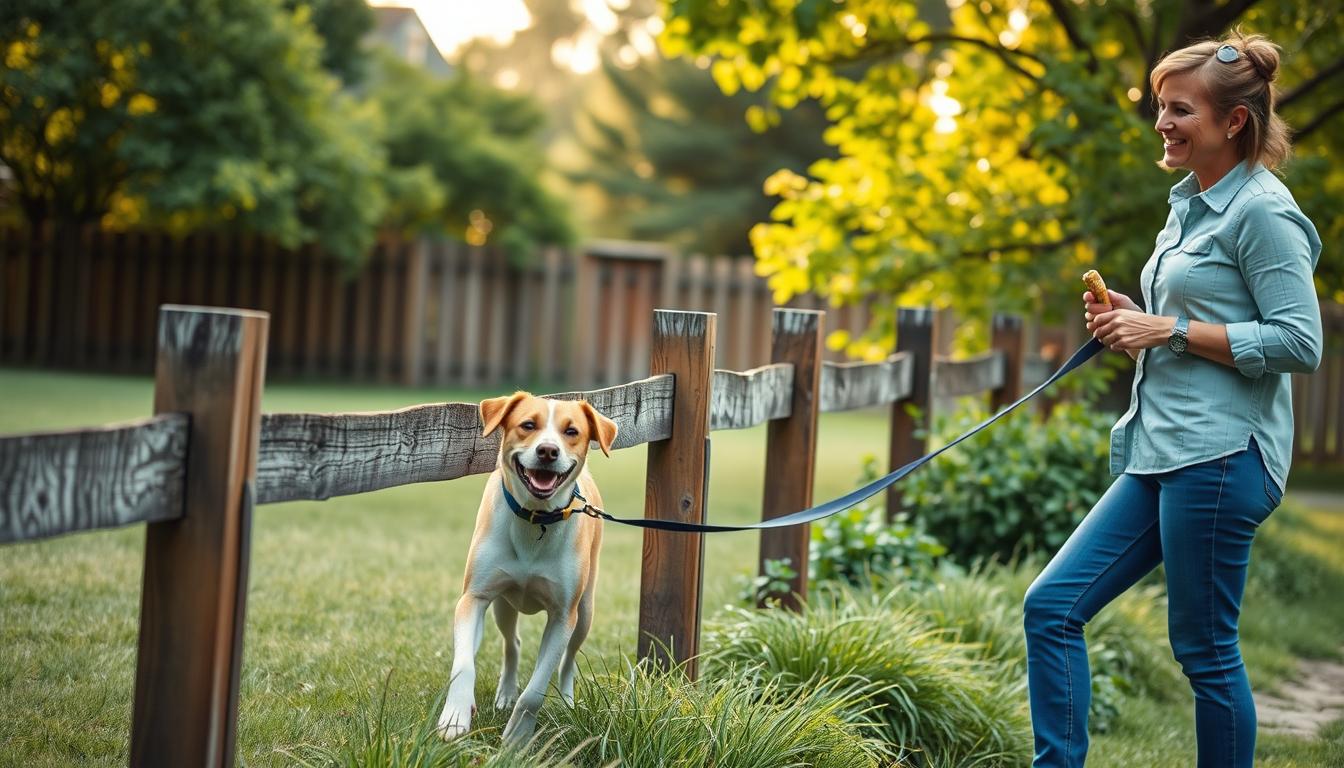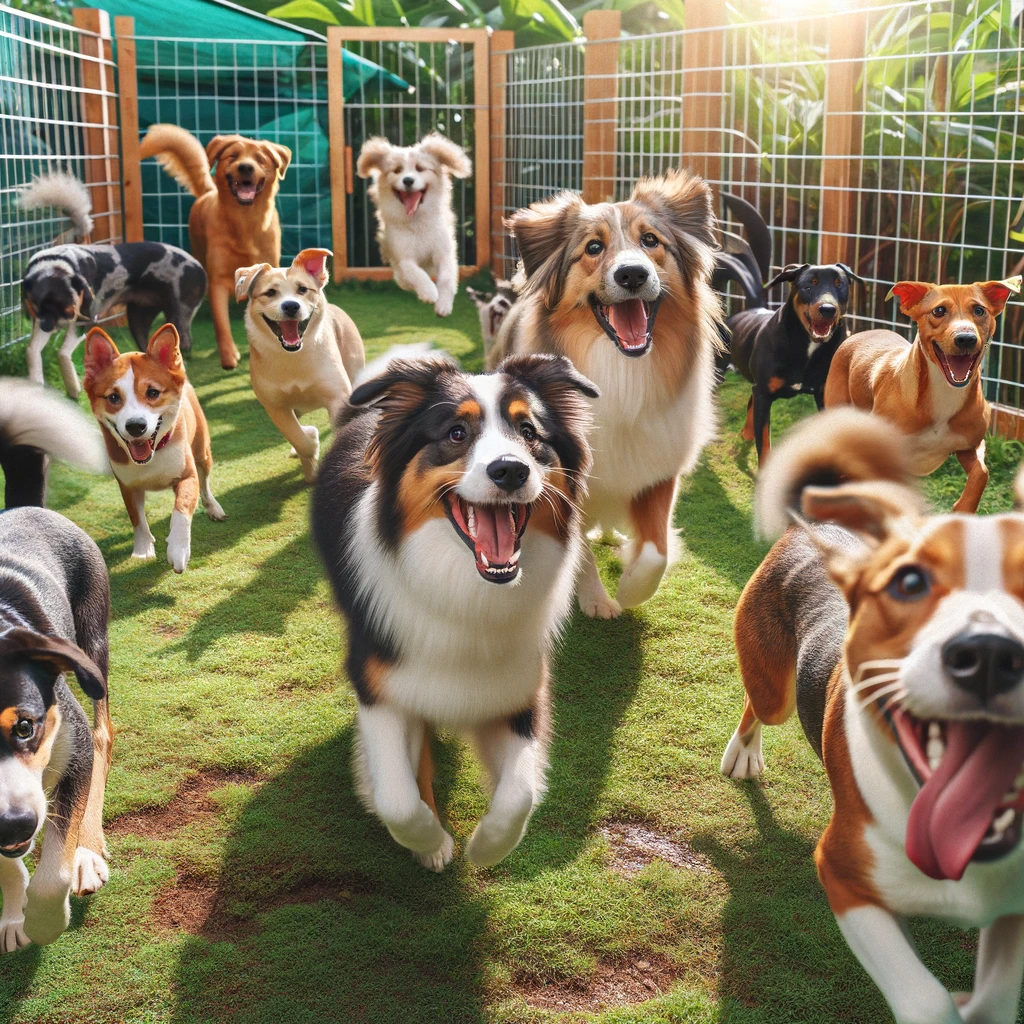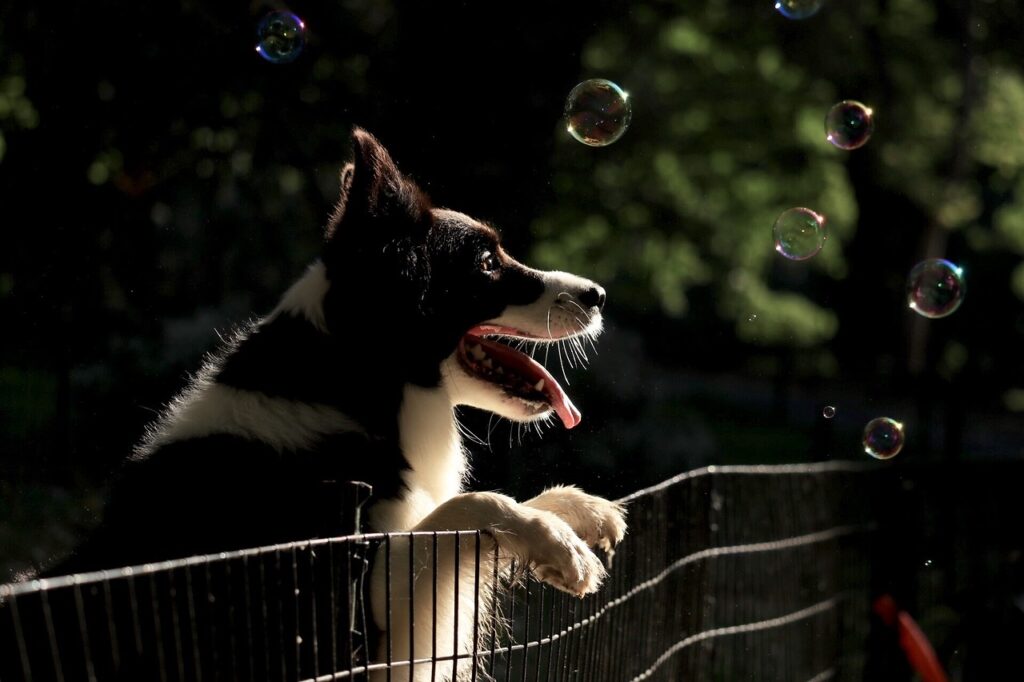This blog contains affiliate links. If you click and purchase through them, I may earn a small commission at no extra cost to you. I only recommend products I trust and would use myself.
Teaching your pet to respect the fence without using shocks or yelling is kind and works well. By using positive reinforcement techniques, you can see great changes quickly.
Dog fence training is essential for ensuring your pet respects the boundaries without stress or discomfort.
Old methods often use punishment, which hurts your pet. Our way is different. We focus on rewarding good behavior. This makes a safer and happier place for you and your pet.
Key Takeaways
- Positive reinforcement is key to successful boundary training.
- Avoid punishment-based methods for a healthier pet.
- Consistency and patience yield the best results.
- Visual markers and cues can enhance the training process.
- Rewarding good behavior encourages respectful fence behavior.
Why Dogs Escape: Understanding Fence-Jumping Behavior
To train your dog to stay in, first figure out why they try to get out. Dogs don’t jump fences just to escape. There’s usually a deeper reason.
Common Motivations for Escape
Dogs may try to escape for many reasons, including:
- Boredom and lack of stimulation: Dogs need both mental and physical activity. Without it, they might look for fun outside.
- Separation anxiety: Some dogs escape when left alone because they’re upset.
- Curiosity and instinct: Some breeds are naturally curious or have a strong prey drive. This makes them want to explore beyond their fence.
- Mating or socialization: Intact dogs might escape to find a mate or to play with other dogs.
Breed-Specific Tendencies
Some breeds are more likely to escape because of their original purpose or genetics. For example:
- Herding breeds like Border Collies and Australian Shepherds may try to escape to herd animals or people.
- Hunting breeds such as Beagles and Terriers might follow their noses and escape to chase small game.
Knowing your dog’s breed can help you train them better.
Identifying Your Dog’s Escape Triggers
To stop your dog from escaping, find out what makes them try. Keep a log of when they try to escape and look for patterns. Are there certain times or things that make them want to go out? Once you know what triggers it, you can make a plan to train them.
By figuring out why your dog escapes and fixing the problem, you can start using fence training for dogs methods. These will help keep them safe in your yard.
The Problem with Punishment-Based Boundary Training
Punishment methods like shock collars and yelling harm your dog’s well-being. They don’t solve the problem of why your dog escapes.
Why Shock Collars Can Backfire
Shock collars aim to stop dogs from crossing boundaries with an electric shock. But, this can make things worse. Your dog might get anxious or scared, linking the shock to you or the area. This can cause fear-based aggression.
The Negative Effects of Yelling at Your Dog
Yelling at your dog is harmful. It makes them stressed and more likely to try to escape. Yelling doesn’t teach them to stay; it makes them fear your anger.
Long-term Behavioral Consequences
Punishment training can have lasting, bad effects. Dogs may suffer from chronic anxiety, leading to destructive behavior and stress. Choosing non-punishment methods helps your dog respect fences without harming their mental health.
Knowing the dangers of punishment training helps you choose safer, non-shock boundary training options. These methods focus on your dog’s safety and happiness.
Positive Dog Fence Training: The Humane Alternative
Positive reinforcement can change how you train your dog to stay in the fence. It’s different from methods that punish bad behavior. Instead, it rewards good actions, making your pet safer and more respectful.
The Science Behind Positive Reinforcement
Positive reinforcement uses rewards to teach your dog to stay in the fence. It’s based on the idea that good actions get rewarded. This method uses treats, praise, and more to teach your dog to stay in.
Benefits for Your Dog’s Mental Health
Positive reinforcement helps your dog’s mental health a lot. It lowers stress and anxiety from punishment. By focusing on rewards, your dog learns to trust the training, becoming more confident and calm.
Real Example: Sarah’s Terrier Transformation
Sarah from Colorado trained her terrier, Max, with positive reinforcement. Max used to try to jump the fence a lot. But with rewards, Max learned to stay in the fence area in just weeks. Sarah’s story shows how well positive training works.
| Training Method | Effectiveness | Impact on Dog’s Mental Health |
|---|---|---|
| Positive Reinforcement | High | Reduces stress and anxiety |
| Punishment-Based | Low | Increases stress and anxiety |
Choosing positive dog fence training keeps your dog safe and happy. It’s a kind way to build a strong bond with your pet. This approach leads to a better life for both you and your dog.
Preparing for Successful Boundary Training

Before starting boundary training, get your dog and space ready for the best results. Good preparation is key for a successful training journey.
Essential Equipment and High-Value Treats
You’ll need a few things to begin. A comfy harness, a leash, and high-value treats are must-haves. Pick treats your dog really enjoys and doesn’t get often.
Creating a Distraction-Free Training Environment
Find a quiet spot near your fence for training. Avoid areas with distractions like other dogs, people, or squirrels. This helps your dog stay focused on the training.
Setting Realistic Goals Based on Your Dog’s Personality
Know your dog’s personality and set achievable goals. For instance, high-energy breeds might need more exercise before training. Be patient and adjust your training plan as needed.
| Equipment | Purpose |
|---|---|
| Harness and Leash | Comfortable walking and control |
| High-Value Treats | Motivation during training |
Step-by-Step Dog Fence Training Method
Setting a clear boundary is essential for dog fence training. It starts with a step-by-step approach. This method helps your dog understand and respect the fence without feeling anxious or scared.
Initial Boundary Introduction
The first step is introducing your dog to the boundary. Walk your dog along the fence line on a leash. This lets them get used to the perimeter. It’s a key step in the training process.
The Flag System for Visual Cues
A flag system can help give your dog visual cues. Place flags along the fence line to mark the boundary. As you walk your dog along, they’ll learn to recognize the flags as the limit of their territory.
Leash Work Along the Perimeter
Leash work is vital in dog fence training. Walking your dog along the fence line on a leash helps them understand the boundaries. Repeat this exercise several times until your dog clearly knows the perimeter.
Real Example: Mike’s Border Collie Success Story
Mike, a Border Collie owner, trained his dog using this method. He introduced the boundary gradually and used flags. Mike’s dog learned to respect the fence in just a few weeks. Mike’s success story shows how effective this training method is.
By following this step-by-step dog fence training method, you can ensure your dog respects the fence. They will stay safe within your property’s boundaries.
Effective Reward Cues That Reinforce Boundaries

Using the right reward cues is key in dog fence training. They help your dog know and respect the yard’s limits.
Timing Your Rewards for Maximum Impact
When you reward your dog, timing is everything. Reward them right after they do what you want. This way, they learn to connect their actions with the reward.
Tips for Timing Rewards:
- Reward immediately after the desired action
- Use high-value treats for significant milestones
- Gradually phase out treats as your dog becomes more reliable
Verbal Markers and Their Importance
Verbal markers are vital in dog training. They tell your dog exactly when they’ve done something right. A consistent marker, like “yes,” signals approval.
Example of Verbal Marker Usage:
| Action | Verbal Marker | Reward |
|---|---|---|
| Dog stays within the boundary | “Good boy” | Treat and praise |
| Dog responds to recall cue | “Yes” | Treat and affection |
Phasing Out Treats Without Losing Effectiveness
When your dog respects the boundary well, start to use fewer treats. This helps your dog not rely too much on rewards. They’ll keep respecting the fence even without treats.
By using these methods and effective reward cues, your dog will learn the yard’s boundaries well.
Training Differences: Physical vs. Invisible Fences
Knowing the difference between physical and invisible fences is crucial for training your dog. The fence type greatly affects how you should train your dog.
Adapting Methods for Different Fence Types
Training a dog requires considering the fence type. Physical fences are clear and easy for dogs to see. On the other hand, invisible fences use sounds or vibrations that dogs can feel.
With physical fences, you can use the fence as a visual aid. Invisible fences need clear sounds or vibrations for dogs to understand.
Visual Boundary Markers for Invisible Fences
Using visual boundary markers is a smart move for invisible fences. Flags or other markers help dogs connect the invisible boundary with something they can see.
Real Example: Jennifer’s Beagle and the Invisible Fence
Jennifer trained her Beagle with an invisible fence using visual markers and rewards. She placed flags along the boundary and rewarded her dog for staying inside.
By understanding the unique needs of physical and invisible fences, you can create a training plan that works best for your dog.
Consistency: The Key to Lasting Fence Respect
To get lasting results in dog fence training, being consistent is crucial. It helps your dog know what’s expected of them. This reduces confusion and makes them respect the fence more.
Creating a Family Training Plan
A family training plan is key for dog fence training success. Make sure everyone agrees on commands, rewards, and boundaries. This avoids mixed signals that confuse your dog.
- Discuss and agree on training methods and commands.
- Establish a reward system that everyone follows.
- Schedule regular training sessions that all family members can attend.
Handling Setbacks Without Frustration
Setbacks are part of training. It’s important to handle them calmly to keep training positive.
Remaining calm and patient is crucial.
If you hit a snag, rethink your training plan and make changes as needed.
Maintaining Training During Different Seasons
Seasons can change things up. Keep your dog’s training on track by adjusting to these changes.
| Season | Potential Distractions | Training Tips |
|---|---|---|
| Summer | More outdoor activities, visitors, and wildlife | Increase training sessions during less busy times, use higher value rewards. |
| Winter | Snow, colder weather, less outdoor time | Maintain indoor training sessions, focus on recall commands. |
| Spring | Blooming plants, more outdoor activities | Use the renewed energy to practice boundary training in new environments. |
By sticking to a consistent training plan, your dog will learn to respect the fence. This keeps them safe and gives you peace of mind.
Troubleshooting Common Fence Training Challenges
Dealing with fence training challenges is key to keeping your dog safe and happy. Even with the best plans, you might face issues that need a change in your training strategy.
The Persistent Escape Artist
If your dog keeps trying to get out, it’s time to look at your training again. Consistency and patience are crucial in fixing this problem.
Dealing with Distractions
Things like squirrels, neighbors, or other dogs can mess up your training. To beat this, gradually introduce distractions in training, rewarding your dog for staying focused.
When to Consider Professional Help
If you can’t solve training problems by yourself, it’s time to get help. Signs that you need help include constant escape tries or not responding to training signals.
Signs Your Training Needs Adjustment
- Frequent escape attempts
- Lack of response to boundary cues
- Increased anxiety or stress during training
Finding a Positive Reinforcement Trainer
When looking for a professional trainer, find one who uses positive reinforcement techniques. This method makes sure your dog gets good and kind training.
Realistic Timeframes: What to Expect Week by Week
Getting your dog to stay in the yard takes time and patience. It’s a journey with different stages and challenges. Each step has its own goals and obstacles.
Foundation Building
The first two weeks are all about laying the groundwork. You’ll introduce your dog to the fence, use positive methods, and keep training sessions short. Being consistent is crucial here.
A professional dog trainer says, “The first weeks are key. They set the tone for the whole training. Stay patient and keep it consistent.”
“The way to get started is to quit talking and begin doing.” – Walt Disney
Testing Boundaries
By weeks 3-4, your dog should know the fence well. Now, it’s time to test their knowledge with distractions and more freedom. This phase is vital for reinforcing their learning.
Solidifying Training
Months 2-3 focus on making the training stick. Your dog should understand the fence well. It’s time to make their responses to commands and distractions better. This phase includes more challenging training.
Long-Term Maintenance Strategies
For long-term success, you need to keep up the training. This means regular sessions, positive reinforcement, and watching for any fence issues. A good maintenance plan keeps your dog well-behaved over time.
| Training Phase | Key Activities | Expected Outcomes |
|---|---|---|
| Weeks 1-2 | Introduction to boundary, positive reinforcement | Familiarity with the boundary |
| Weeks 3-4 | Testing understanding, introducing distractions | Improved boundary respect |
| Months 2-3 | Refining response to commands, complex scenarios | Solidified training |
By following this structured plan, you can train your dog to respect the fence. This ensures a safe and happy place for your pet and the community.
Conclusion: A Happier Dog Within Safe Boundaries
Training your dog to respect the fence without shocks or yelling is doable and good for their health. Positive reinforcement training makes your dog happier and safer. It rewards good behavior, strengthening your bond.
Understanding your dog’s needs, preparing a quiet space, and using treats are key. These steps help your dog learn the fence’s boundary well. This reduces escape risks and dangers.
With patience and positive training, your dog will feel safe and happy in your yard. This improves their life and gives you peace of mind. You’ll know they’re protected and content.
FAQ
What is the best way to train my dog to stay within the yard?
The best way to train your dog is through positive reinforcement. Use reward-based training and create a distraction-free environment.
Why do dogs escape from the yard?
Dogs may escape for many reasons. These include breed-specific tendencies and lack of exercise or mental stimulation. They might also be triggered to jump the fence.
Are shock collars effective for fence training?
No, shock collars are not recommended. They can harm your dog and lead to long-term behavioral issues. Focus on positive reinforcement instead.
How do I prepare my dog for boundary training?
To prepare your dog, gather essential equipment and high-value treats. Create a distraction-free environment. Set realistic goals based on your dog’s personality.
What is the flag system in dog fence training?
The flag system is a visual cue. It marks the boundary and helps your dog understand where the yard ends.
How do I phase out treats during fence training?
Start by reducing the frequency of rewards. Then, switch to verbal markers and praise. This keeps the training effective.
Can I use the same training method for physical and invisible fences?
The core principles of positive reinforcement are the same. But, you might need to adapt your method for different fences. Use visual markers for invisible fences.
How long does it take to train my dog to respect the fence?
Training time varies. But, with consistent training, you’ll see progress in weeks 1-2. Testing boundaries happens in weeks 3-4. Solidifying training takes months 2-3.
What if my dog is a persistent escape artist?
If your dog is a persistent escape artist, seek professional help. They can help identify issues and create a customized training plan.
How do I maintain fence training during different seasons?
To maintain training, be consistent. Adjust to seasonal distractions and reinforce good behavior.





